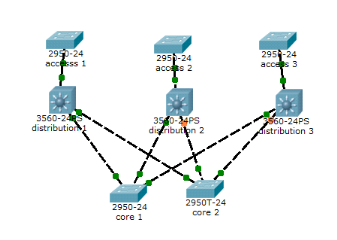2.7. 4.4.3.5
Hierarchical network
In a hierarchical design all connecting devices are still on the
same level, but these are interconnected at a level above it

Figure 4.4. Hierarchical design
In the traditional Cisco network design model there are three
basic levels
1. Access: Where switching is the primary
activity.
2. Distribution: Where routing occurs.
3. Core: Which forms a backbone for connecting
the distribution level segments of large networks.
Due to significant benefits of hierarchical design over flat
design which including
Ø The network is easy to scale
Ø The problem domain can be more easily isolated
Ø It creates logical interconnection points where
protocols changes can occur Failure in
Table comparison between hierarchical and flat network
design
|
Flat Network
|
Hierarchical Network
|
Advantages
|
Uses for small network and statics
|
Large and enterprise network
|
|
Single collision domain
|
large
|
|
|
Scalable, manageable
|
Limitations
|
Limited number of stations
|
unlimited
|
|
Single point of failure
|
no
|
|
Broadcast domain layer 3 switches and router
|
Have 3 layers;
Access. Distribution and core
|
Table 4.2. Comparisons between hierarchical and flat
network design
Note: We have decided to choose this
model which will be adequate for our network to make it efficient compare to
the current network which use flat network design
| 


